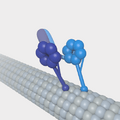Microtubule facts for kids
Microtubules are tiny, hollow tubes found inside cells. They are a key part of the cell's internal support system, called the cytoskeleton. Think of them like the cell's scaffolding or a network of tiny roads. They are made from building blocks called tubulin molecules.
Contents
What are Microtubules?
Microtubules are like very small, hollow noodles. Their walls are built from 13 columns of tubulin molecules, which are special proteins. These tubes are always being built up and taken apart, allowing cells to change their shape and move things around inside.
What Do Microtubules Do?
Microtubules have several super important jobs in a cell:
- Keeping Cell Shape: They act like the cell's skeleton, helping it keep its shape and resist squishing.
- Cell Movement: They help some cells move around. For example, they are part of structures like cilia and flagella that help cells swim.
- Moving Chromosomes: During cell division, when a cell splits into two, microtubules form a special structure called the spindle apparatus. This structure helps pull the cell's chromosomes apart equally into the new cells.
- Moving Cell Parts: They act like tracks for tiny "motor proteins" that carry organelles (small parts inside the cell) and other materials from one place to another within the cell. This is especially important in nerve cells, where they help move signals and materials along long nerve fibers.
How Are Microtubules Built?
Microtubules are made from two types of tubulin proteins: alpha-tubulin and beta-tubulin. These two types join together to form a "dimer." Many of these dimers then link up end-to-end to form long chains called protofilaments. Thirteen protofilaments then line up side-by-side to form the hollow tube of a microtubule.
Where Are They Found?
Microtubules are found in almost all eukaryotic cells, which are cells that have a nucleus and other organelles. They are especially common in nerve cells, where they help transport important chemicals and parts along the long extensions of the nerve cell. They are also key parts of centrioles, which are structures involved in cell division.
Images for kids
See also
 In Spanish: Microtúbulo para niños
In Spanish: Microtúbulo para niños









